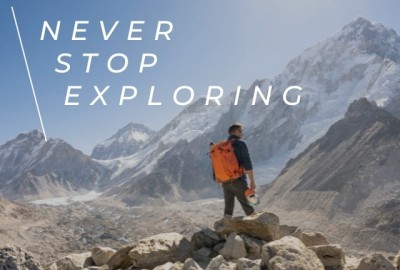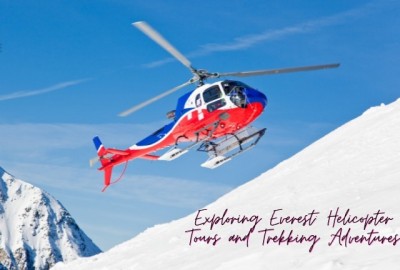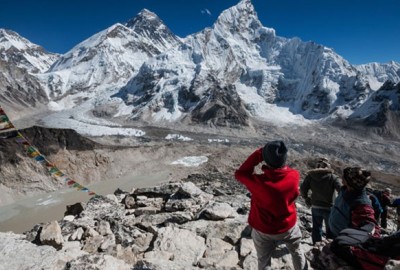Everest Base Camp Trek is a trail of discovery that leads the hiker through the Khumbu Valley in the Nepalese Himalayan Mountains leading to the most famous place in mountaineering history, Everest Base Camp. This premier trek offers the opportunity to walk through Sagarmatha National Park, a UNESCO World Heritage Site, which is home not only to Mt Everest (8,848m) but a wealth of other incredible mountains and their surrounding landscapes.
Many travelers every year during the Spring season (March to May) and Fall (September to November) fly into Kathmandu, Nepal to begin one of the best adventures, opening the door to understanding new and different cultures, lifestyles, customs, and religions. Everest Base Camp Trek is not just a walk through rugged and wild mountains, with stunning alpine scenery around every corner, but it is also a grand adventure into the exciting world of cultural discovery.
Everest Base Camp Trek is a wonderful choice for an international holiday and will certainly provide to be the journey of a lifetime, but it is also a serious undertaking with some physical and mental challenges involved. Here are seven great tips to get you started on preparing for this incredible adventure.
Choosing a Trekking Company: Why Local Providers Can Be a Great Option
There are a lot of choices when it comes to finding a trekking company when deciding to hike the Everest Base Camp. Any search on the internet will display hundreds of options for someone to choose from. One way to make a social and economic difference, and get incredible service is by choosing a local provider. It is one of the best ways to support the local economy. Nepal has many well qualified, safe, highly organized, trekking and mountaineering companies with staff who fully accredited by international standards. So in choosing a local trekking company offers the same level or at times a higher level of service than outside sources. With this high level of service, the money spent will also stay within Nepal, where it is needed to help build strong, sustainable economic development.
Basic Itinerary and Daily Activity
The trek will last anywhere between 15 to 19 days depending on the itinerary you have decided upon with your trekking company. Each day will consist of up to 8 hours of physical activity, this includes walking on uneven, sometimes rocky, snowy, muddy, icy, or all the above-combined terrain. You will be carrying a small daypack with extra layers for warmth, and weather, as well as basic sundries, needed to protect against solar rays, along with water and snacks. Generally, your pack will weigh between 6 to 8 kg, but of course could always be more, or less depending on what you like to have access to throughout the day.
The elevation gained, and loss is significant each day, typically 500 meters can be gained and lost in a day of trekking. This is all done at elevations well over 4,000m (3.3ft to 1 meter). The trekking primarily starts after a flight into Lukla which is at 2,860 meters and culminates with a side trip to the summit of Kala Patthar at 5,643 meters.
Medications
Once you and your doctor have discussed what your actions will be, and you have been cleared, you may have questions concerning what types of vaccinations and/ or medications are important to stay healthy in Nepal. Medication questions should be a discussion between you, your trekking company, and your doctor and are beyond the scope of this article. You will read lots of suggestions, but please be careful as to who is doling out the advice and in what context. Too many times travelers have gotten into trouble with self-medicating because they read online that a particular product is “really important to have”. For example, travelers have been taking a certain broad-spectrum antibiotic for traveler’s diarrhea, however, in Nepal, this medication has been used so pervasively that there are resistant bacteria now to this particular antibiotic.
Vaccinations
As stated before the best conversation regarding vaccinations is between you, your trekking company and your doctor. Telling your doctor that you will be flying into Kathmandu, and spend a few days there, then trekking from sub-tropical forests up into alpine environments in Nepal is important. If your doctor doesn’t know exactly what you need, they will confer with colleagues to confirm proper vaccinations. However, at the moment there are no vaccinations legally required to enter or exit Nepal.Re
Related Blog:
Everest Base Camp and Altitude Sickness
Everest Base Camp Trek for Beginners
Training Progression
As stated previously, the day to day activity includes 8 hours of physical activity on uneven terrain, with a day pack, for at least 15 days at elevations above 3,000 meters. To train for the Everest Base Camp Trek the most important thing to remember is, training needs to be progressive gradually increase your training program.
Endurance training should be the foundation. To prepare for a moderate trek you should begin training at least four to five months before your departure. Generally, an hour of aerobic exercise three to four times per week would be considered a minimum requirement. Adding some resistance training at least two times a week is preferred. Think gradual progression with all aspects of training. Ideally, the best preparation is hiking involving relatively steep ascents and descents. If you can manage a couple of valley floor to ridgeline ascents per hike with your weighted pack, albeit with stops along the way, you will cope with a moderately graded trek.
Altitude
As you increase in elevation, the amount of oxygen available will decrease. This means your body will have less oxygen to carry out the work being asked of it. Your body goes through many physiological changes to compensate for this change, and during the process, you may experience a range of symptoms. These include but are not limited to:
- A headache
- Tiredness
- Disturbed sleep
- Loss of appetite/nausea
- Shortness of breath
- A cough
- Palpitation
- Swelling of the hands and face
This is called Acute Mountain Sickness or AMS. What fitness does help with is being more familiar with what feels normal, and how to handle physical stress. Exercising means you know what it feels like to be out of breath and how to calm yourself when feeling this way. Your best strategy is to take your time and drink plenty of water. These symptoms may not indicate the onset of A.M.S. and if you experience them it does not necessarily mean that you should not continue. Group leaders should have extensive wilderness first aid training and it is vital you tell your guide or trip leader how you are feeling. AMS can progress to a more life-threatening condition, and your guide will know from your signs and symptoms if this is happening. Descent is the first line of defense if AMS is feeling overwhelming for you, or if it is progressing to something more serious.
Gear and Clothing
With variable weather and terrain, it is important you are prepared with a system of clothing that allows you to “layer”. This means you can take layers on and off as needed to manage cold and wind or rain. Here are the basics but check with your trekking company to see if they have any special requests.
- Base Layer Tops and Bottoms (synthetic or wool)
- Day Pack (21L-35L)
- Day Pack Rain Cover
- Duffel Bag (No Wheels or Rigid Frames)
- Fleece Pants
- Fleece/Wool Gloves
- Fleece/Wool Hat
- Jacket or Sweater (non-cotton)
- Headlamp with Fresh Batteries
- Hiking Boots
- Hiking Pants (Convertible, Quick-Dry, Lightweight)
- Hiking Socks (Synthetic or Wool)
- Insulated Jacket
- Rain Jacket (Hooded, Lightweight, Waterproof, Breathable)
- Rain Pants (Lightweight, Waterproof, Breathable)
- Sleeping Bag (1°-14°, Lightweight, Compressible) Sunglasses (appropriate for high UV exposure)
- Sun Block and Lip Balm
- Sun Hat
- Water Bottles (Two 1-Quart) or Hydration System Plus
- Bandana
- Camp Towel
- Gaiters (Tall)
- Liner Socks (Synthetic)
- Personal Bathroom Kit: Toilet Paper, Ziplock Bags, Personal Wipes, Hand Cleaner
- Personal First Aid Kit/Medications (Lightweight)
- Stuff Sacks
- Tee Shirts (Synthetic)
- Trekking Poles
- Down Booties (Colder Weather Travel Periods)
- Ear Plugs
- Electrical Adapter Plug and Converter
- Sleeping Bag Liner
- Solar Charger
- Water Purification Drops/Tablets
One often overlooked aspect of traveling to high altitudes is the exposure to UV. Not only does the available oxygen decrease with altitude, but the UV exposure increases dramatically. Please be prepared with higher than you usually wear sunblock, and lip balm with sunblock in it. A wide-brimmed sunhat is also recommended as well as a long sleeve trekking shirt. Not all of these items are necessary, but this list has been compiled by those who have had experience and you would probably be remiss if you didn’t have. Other of these items are required.
Everest Base Camp Trek is a phenomenal opportunity not to be missed. The scenery you will encounter is beyond words, and only those who have witnessed, and experienced the majesty of the Himalayan Mountains can really express the feelings they have inspired. Not only is the Khumbu Region of the Himalayan resplendent with incredible landscapes, but the cultural opportunities are also not to be missed. The chance to interact with traditional mountain cultures that, though the modern world has completely enveloped them, they have retained their traditions, language, and religion superbly. To get ready for this trip of a lifetime should be a process to be relished. Enjoy the beauty, the wonders, and the magnificence of the Everest Base Camp Trek!
For booking your trip, or for further information on this trek, feel free to contact us.


